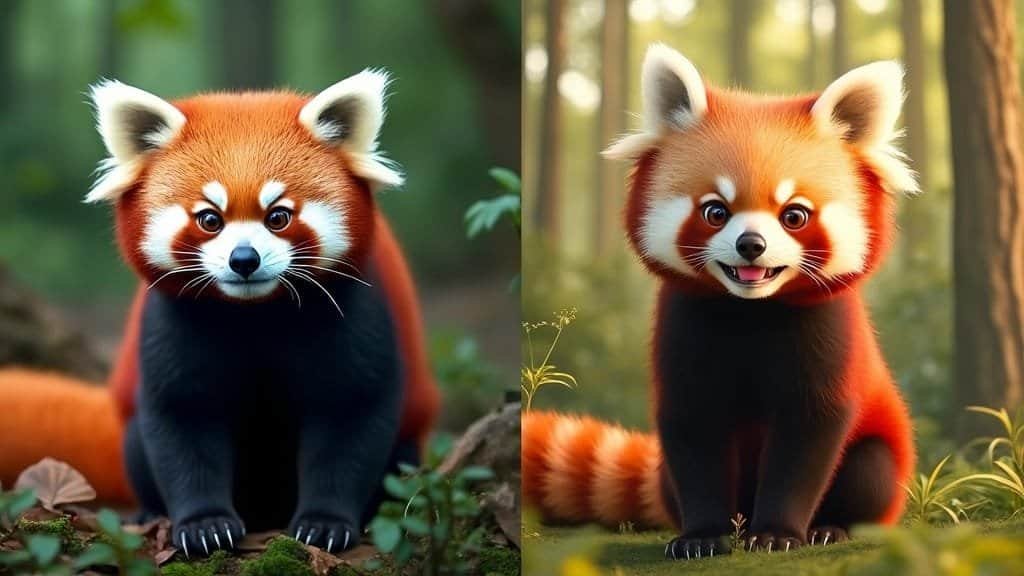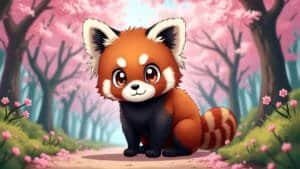Introduction
Red pandas, with their unique appearance and playful behavior, have become popular characters in animation. However, their portrayal often exaggerates their physical features, humanizes their emotions, and simplifies their behaviors to fit storytelling needs
While these creative liberties endear them to audiences, they can also lead to misconceptions about the species
This article explores the key differences between real red pandas and their animated counterparts, examining how animation influences public perception and contributes to conservation awareness
Physical and Behavioral Differences Between Real and Animated Red Pandas
While animated red pandas capture the charm of their real-life counterparts, their portrayals often differ significantly in appearance, behavior, and expressions
These differences stem from creative liberties taken by animators to enhance their appeal and connect with audiences
How Animated Red Pandas Exaggerate Physical Traits
Real red pandas are small mammals with a unique appearance, including reddish-brown fur, a bushy ringed tail, and a masked face with white markings. In animation, these features are often exaggerated for visual appeal
For example, animated red pandas may have oversized eyes to emphasize expressiveness or exaggerated tails to highlight their playful nature
Their fur is often rendered in brighter, more vibrant shades of red and orange than what is seen in the wild, making them stand out in colorful animated worlds. Proportions are frequently altered as well—animated red pandas might appear rounder or more compact to enhance their cuteness
An example of this is Disney-Pixar’s Turning Red, where the red panda character Mei transforms into an oversized, fluffy version of a red panda with exaggerated facial expressions and anthropomorphic movements. While visually engaging, these designs prioritize storytelling over biological accuracy
Real Red Panda Behavior vs. Animated Portrayals
In the wild, red pandas are solitary, shy creatures that spend much of their time foraging for bamboo or resting in trees. Their movements are deliberate, and they exhibit behaviors like scent-marking, climbing, and slow, cautious locomotion
Animated red pandas, however, are often portrayed as energetic and highly interactive
They are frequently shown engaging in playful antics, performing acrobatic stunts, or forming close bonds with other characters. While this makes them more relatable and entertaining for audiences, it departs from the more reserved and solitary nature of real red pandas
For instance, in the animated series We Bare Bears, the red panda character Charlie is outgoing, humorous, and social—qualities that differ markedly from the behavior of actual red pandas
The Use of Human-Like Expressions in Animation
One of the most notable differences between real and animated red pandas is their emotional expression. Real red pandas have limited facial mobility, often appearing calm or neutral. They communicate primarily through body language and vocalizations, such as squeals or whistles
In contrast, animated red pandas are anthropomorphized, given human-like facial expressions and exaggerated emotions. These characters can smile, cry, blush, or express fear and anger in ways that mirror human behavior. This technique helps animators convey complex feelings and make red pandas more relatable to viewers, especially children
While these portrayals enhance storytelling, they can lead to misconceptions. Audiences may assume that real red pandas display similar emotional expressiveness, which could skew perceptions of their natural behaviors and needs
By understanding these differences, audiences can better appreciate both the creative liberties taken in animation and the authentic characteristics of real red pandas
Storytelling and Symbolism in Animated Red Pandas
The red panda’s unique appearance and endearing characteristics make it a popular choice for animators. In addition to their visual appeal, animated red pandas often embody deeper themes and serve as symbolic figures in storytelling
These portrayals, while entertaining, can shape public perceptions of the species and introduce both positive messages and misconceptions
Why Red Pandas Are Popular Choices in Animation
Red pandas are a natural fit for animation due to their distinct physical traits and perceived playfulness. Their fluffy tails, masked faces, and agile movements lend themselves to dynamic and expressive animation styles
Moreover, red pandas are relatively lesser-known animals compared to iconic species like lions or elephants. Their novelty makes them a fresh and intriguing subject for animators looking to stand out. Characters based on red pandas often exude charm and curiosity, qualities that resonate with audiences of all ages
In Turning Red, for example, the red panda serves as a metaphor for adolescence and the emotional upheavals that come with growing up. This creative use of the red panda character as a symbolic figure adds layers of meaning to the story while showcasing the animal’s appeal
Themes and Messages Conveyed Through Red Panda Characters
Animated red pandas often carry messages of self-discovery, environmentalism, or the importance of friendship. Their solitary yet resilient nature in the wild translates well into stories about personal growth or overcoming challenges
For example, in the children’s show Kung Fu Panda: The Paws of Destiny, a red panda character mentors the main protagonists, emphasizing wisdom, guidance, and the connection between humans and nature. Such portrayals highlight the red panda’s association with themes of balance and harmony
Additionally, animated red pandas frequently appear in narratives about environmental conservation. By depicting them in lush, vibrant forests, creators draw attention to the beauty and fragility of their habitats, subtly encouraging viewers to value and protect natural ecosystems
Misconceptions About Red Pandas Caused by Animation
While animated portrayals of red pandas are often well-intentioned, they can lead to misconceptions about the species
One common misunderstanding is the belief that red pandas are overly energetic, social, or expressive, as seen in many animated characters. In reality, they are more reserved and spend much of their time alone or sleeping in trees
Another misconception involves their diet. Animated red pandas are often shown eating a variety of foods, such as fruits or human snacks, to create relatable or humorous moments. In reality, red pandas are highly dependent on bamboo and require specific dietary conditions to thrive
These portrayals, while entertaining, may skew public understanding of the species and their conservation needs. For instance, viewers might underestimate the challenges red pandas face in the wild, such as habitat loss and the scarcity of bamboo, because animated versions often present them as adaptable or carefree
By balancing entertainment with educational content, animators can celebrate the red panda’s charm while fostering accurate awareness of its behaviors and vulnerabilities
The Impact of Animated Red Pandas on Conservation
Animated portrayals of red pandas have the potential to influence conservation awareness by highlighting the species’ charm and ecological importance
However, the anthropomorphizing of red pandas also presents challenges, as it can create unrealistic expectations or misunderstandings about the species
This section explores the benefits and drawbacks of using animated red pandas to promote conservation, as well as the ways in which real red pandas inspire their animated counterparts
Raising Awareness Through Animated Red Panda Characters
The popularity of animated red pandas introduces the species to audiences who may otherwise be unfamiliar with them
Films, television shows, and digital content featuring red pandas generate interest in their unique appearance and behaviors, encouraging viewers to learn more about the real animals
For example, the release of Turning Red sparked a surge of online searches and discussions about red pandas, leading many people to discover their endangered status and the importance of protecting their habitats
Similarly, the animated character Retsuko, from the series Aggretsuko, has brought attention to red pandas in a unique and modern context, blending themes of individuality and resilience
By showcasing red pandas as lovable and relatable characters, animators create a sense of emotional connection that can inspire conservation actions, such as supporting zoos, donating to wildlife organizations, or advocating for habitat protection
Benefits and Challenges of Anthropomorphizing Red Pandas
One of the key benefits of anthropomorphizing red pandas in animation is their ability to evoke empathy. When audiences see red pandas displaying human-like emotions, such as joy, fear, or sadness, they are more likely to care about their well-being
This emotional engagement can translate into increased support for conservation efforts
However, anthropomorphism also poses challenges. Over-humanizing red pandas can lead to unrealistic expectations about their behavior and ecological needs
For instance, audiences might assume red pandas are as adaptable or social as their animated counterparts, underestimating the critical role of bamboo forests and the challenges of habitat fragmentation
To strike a balance, creators can integrate factual information into animated portrayals. For example, educational content accompanying animated series or films could include behind-the-scenes documentaries, partnerships with conservation organizations, or outreach campaigns that share accurate insights about red pandas
Real Red Pandas’ Influence on Animated Design
The design and behavior of animated red pandas are often inspired by real observations of the species
Animators frequently study red pandas in zoos or their natural habitats to capture their unique movements, gestures, and expressions. These details make animated red pandas feel authentic while allowing for creative exaggeration to fit narrative needs
For instance, the climbing agility and tail-swishing behaviors seen in many animated red pandas are rooted in real-life traits. Similarly, their natural shyness and curious demeanor are often incorporated into character personalities, adding depth to their on-screen roles
By grounding animated portrayals in the biology and behavior of real red pandas, creators honor the species while enhancing their storytelling. This approach not only entertains but also educates audiences about the real animals behind their favorite characters
Conclusion
The differences between real red pandas and their animated counterparts reveal the creative liberties taken by storytellers to engage audiences
While animated red pandas often exaggerate physical traits, behaviors, and emotions to enhance relatability and visual appeal, these portrayals can also lead to misconceptions about the species’ true nature
Despite these challenges, animated red pandas play a significant role in raising awareness about conservation. By captivating audiences and fostering emotional connections, they inspire interest in the plight of real red pandas and their endangered habitats
When paired with educational efforts and accurate information, these portrayals can serve as powerful tools for promoting wildlife protection
Understanding the balance between entertainment and education is key to leveraging animated red pandas as ambassadors for conservation. By appreciating both their fictional charm and real-world significance, audiences can contribute to preserving this iconic species for generations to come









